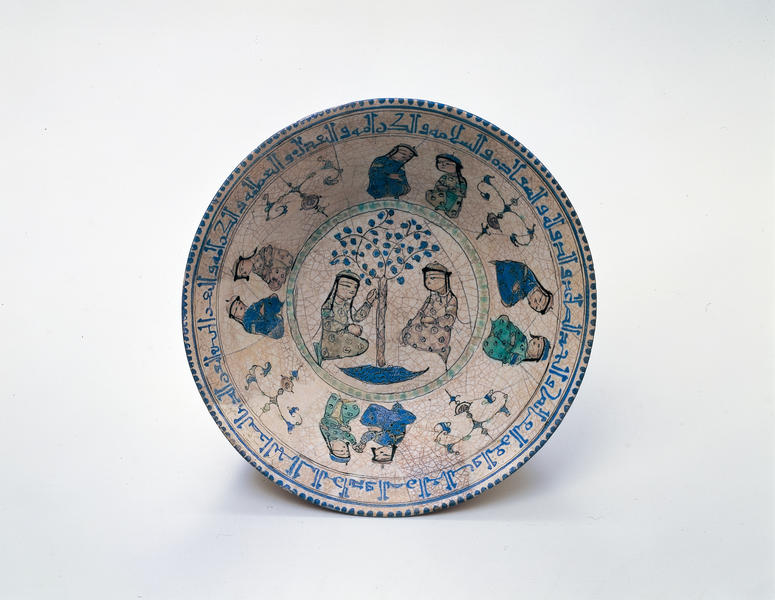色絵樹下人物図鉢
- イラン
- セルジューク朝時代
- 13c
- 複合陶土
- H-8.3 D-20
中央に一本の樹木が植えられその根元に小さな池があり、男女が向かい合った姿が描かれている。見込み部分にはアラベスクで仕切られた空間に4組の男女が向き合い、その中の1組は手を握り合っている。口縁部にクーフィー体のアラビア語の銘文が書かれている。コバルト・ブルーとトルコ・ブルーが基調になっているため冷ややかな印象を与えるが、荘重で静かな雰囲気に包まれた作品である。
Catalogue Entry
In the center of this bowl, a couple sit facing each other under a tree, which separates them. The design motif of a single tree with either people or animals symmetrically placed to its right and left occurred widely in ancient West Asia, where the belief that trees were sacred was widespread and their worship was popular. The design persisted through Sasanian Persia and on into the Islamic period, and although the original meaning behind the motif was eventually lost, it continued to be appreciated for its aesthetic balance. Surrounding the central scene is a band with four couples, also facing each other; one couple is shown holding hands. The person on the left in the couple at the center is shown holding up one hand, but as it is empty it is quite clear that this is not a scene of eating and drinking. In this piece of mina'i ware, the keynote is the rendering in cobalt blue and turquoise blue, which gives the entire piece a somewhat cool feeling. The coolness is enhanced by the painter's sneaking in a folk element, the Sun Maid (khorshid khanum), in a double-entendre rendering of the central couple, wherein the tree branches are the maid's hair, its trunk is her nose, the two people are her eyes, and the pool is her mouth. But the grave mood suggests a gathering for poetry reading, moharram recitation, or perhaps meditation.
Close to the lip, there is an Arabic inscription in a continuous circle, in rectangular Kufic script. Inscriptions found on Persian ceramics do not necessarily have anything to do with the subject illustrated, but could be words of praise, blessings, or compliments to the owner of the vessel, a proverb, or a quotation from the Koran. Long poems in Persian were also used. On some pieces, the background history or family's origin (nisbah, the part of a name that indicates the profession or place of origin of the forebears of the holder) appeared; the potter's name, the date of manufacture, and even where the piece was made was recorded, making it extremely valuable as a historical document. On the other hand, there are many cases where pseudo-calligraphy was used merely for decoration.
There is a piece closely resembling this one in the Archaeological Museum in Tehran.1
TS
l. No. 3769; Sugimura l980, pl. 80; Bagherzade et al. 1978, color pl. 71; where it differs greatly is the appearance of a bird, which seems to have special meaning, at the side of a figure. Another comparative example is an overglaze-painted bowl with only one couple under a tree, in the Eisei Bunka Library (Tokyo); Ceramics of the World, vol. 21, pl. 174.
